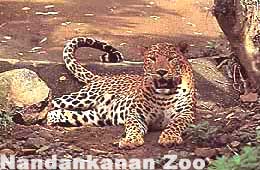
Visit the world famous Nandankanan Zoo, which is known to have the highest White Tiger population. Nandankanan Wildlife Sanctuary and Biological Park is located about 20 kms from Bhubneshwar. It was established as a sanctuary in 1979. Nandankanan or the Garden of Gods is famous for its White Tigers, one of the rarest creatures in the world.
At present Nandankanan Wildlife Sanctuary is home to 34 White Tigers. Apart from White Tigers there are more then 67 kinds of mammals, 16 varieties of reptiles and 81 spices of birds co-exist in the zoo. The Zoo is also the breeding place of Black Panthers, Ghariel Crocodiles, Asiatic Loin, Nilgiri Langer, Indian Pangolin, Mouse Deer and several other birds and reptiles.
It was in 1960 with the help of a former Chief Minister of Orissa that a zoological park could be built giving animals freedom of movement. The first white Tiger was caught by the Maharajah of Rewa in 1951 from the wilds of Madhya Pradesh and given the name Mohan it is more or less guaranteed that one will see a White Tiger even if one does not take the safari for a few are fed in cages where they are clearly visible devouring hunks of meat. Their breeding programme has been a success and there are now 33 White Tigers captive in the zoo. 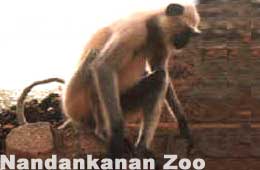 The tawny colored tigers are there too. These spirits of the Indian jungle are territorial animals and usually live solitary lives. They cannot be caged together owing to their ferocity and would mate too often resulting in them shortening their lives. In the wild, they usually only mate during the winter season. Gestation is quick with the result that a litter of cubs will be born in the hot season; it takes much longer than that for them to grow up, however, during which time the male is unwelcome for he may eat the cubs out of hunger.
The tawny colored tigers are there too. These spirits of the Indian jungle are territorial animals and usually live solitary lives. They cannot be caged together owing to their ferocity and would mate too often resulting in them shortening their lives. In the wild, they usually only mate during the winter season. Gestation is quick with the result that a litter of cubs will be born in the hot season; it takes much longer than that for them to grow up, however, during which time the male is unwelcome for he may eat the cubs out of hunger.
There have been a few surprises in the captive breeding of these fine animals. One occurred in 1967, a time when the surrounding area was more forested than it is today. A wild female managed to jump the enclosure wall and be one of the first animals in history to enter a zoo by its own volition. It appears this female had been unable to find a mate in the wild but was successful at Nandankanan. She became known as Kanan and her mate was called Pradeep. Kanan did not produce cubs but lived for more than ten years in captivity, dying in 1978. It is difficult to say exactly how old she was but, generally speaking, tigers live more than twice as long at Nandankanan than they do in other more suburban zoos such as those of Delhi and Calcutta. 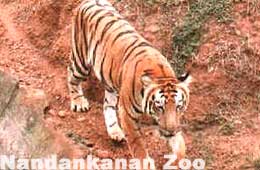
In 1985, a tiger caught in the wild and reared in Darjeeling, was brought to the zoo for breeding purposes since tigers from the wild are considered to possess qualities that captive ones may lack. The tiger is still highly threatened species; it is not because local people kill them through fear but on account of the destruction of their habitat and the fact that they are hunted. People still believe in the magical powers of the tiger to give them strength and the result is an illegal trade, particularly in the bones, of this magnificent beast.
Another captive cat at Nandankanan is the Leopard. These cunning creatures are smaller than tigers, of which they are afraid, and even give jackals a wide berth. They prefer stony and scrubby land and like to rest in trees. A few years ago, a leopard was found in a public toilet in the Madhupatna area of Cuttack and brought to Nandankanan. This surprising discovery shows the extent to which the habitat of such animals is being invaded.
Another cat to be seen in the zoo is the nocturnal Toddy Cat. This animal lets off a musky aroma during the breeding season that can be smelt inside the Nocturnal House where these animals are kept. The Nocturnal House is also home for a jackal as well as a Brown Fish Owl, a large bird that sits incredibly still. I refused to believe it was alive as it sat there unblinking but the guide insisted it was still living.
The Nocturnal House is one of the park's more recent developments that allow one to see animals that one is unlikely to ever see since, in the wild, the night is their time of activity.
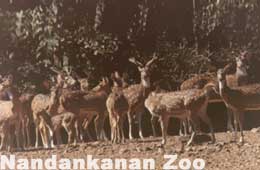 There are caged pond areas for water birds such as the White Ibis, Spoonbill and Painted Stork as well as the larger and more dramatic Rosy and Grey Pelicans. Caged birds include Hornbills with their curved double beaks. Such birds are easier to hear than see for they tend to keep to the upper branches of trees. Unfortunately, their numbers are in decline.
There are caged pond areas for water birds such as the White Ibis, Spoonbill and Painted Stork as well as the larger and more dramatic Rosy and Grey Pelicans. Caged birds include Hornbills with their curved double beaks. Such birds are easier to hear than see for they tend to keep to the upper branches of trees. Unfortunately, their numbers are in decline.
There are a few different species of the Lory or Love Bird to be seen; their bright colors make them special. It is the almost vocal babbling of the Hill Myna that has given it a reputation for being a talker. Other birds include Macaws and a variety of Peasants such as the Silver and Bhutanese.
Other enclosures reveal bears like the Himalayan and Sloth Bear while the One Horned Rhinoceros is another park specialty. The Reptile House is also worth a visit. At the entrance, there stands a life-sized model of a Dinosaur, a creature from a prehistoric age that is now extinct. Among the snakes are King Cobra, a snake that likes to eat other snakes, Rattlesnake, a Python and a Viper. Larger reptiles to be seen are the Estuarine Crocodiles and the Gharials with their curiously long and thin, toothy snout. Their breeding programme here has been a success and many can be seen either floating in the water or stretched out on the sands.
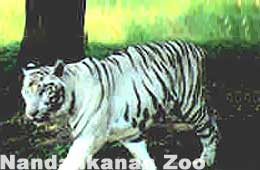 Although most of the animals in the zoo are indigenous to India, there are a few "foreigners" on show. The Jaguar, a medium sized cat for instance, as well as the Cayman, a small sized crocodile, and the Laguna, a kind of lizard-like creature.
Although most of the animals in the zoo are indigenous to India, there are a few "foreigners" on show. The Jaguar, a medium sized cat for instance, as well as the Cayman, a small sized crocodile, and the Laguna, a kind of lizard-like creature.
As well as the animals, there are the plants. Lotuses can be seen on the surface of the Kanjia Lake while on the lakes other side there is a biological park. Among the many plants to be seen here, area selection of over 600 cactuses, said to be the second largest collection in the world.
The best way to enjoy Nandankanan is to go on a safari that is easily arranged within the Park, as there are regular journeys. The best time to do this is early in the morning, before the animals retire from the midday heat, or in the evening when some can be see to re-emerge.
|